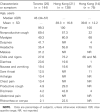Severe acute respiratory syndrome
- PMID: 15156481
- PMCID: PMC7107873
- DOI: 10.1086/420743
Severe acute respiratory syndrome
Abstract
The first cases of severe acute respiratory syndrome (SARS) occurred in China in November 2002. The agent causing this illness has been identified as a novel coronavirus, SARS-coronavirus. Since its introduction <1 year ago, this virus has infected 8098 people in 26 countries, killing 774 of them. We present an overview of the epidemiology, clinical presentation, diagnosis, and treatment of SARS based on the current state of knowledge derived from published studies and our own personal experience.
Figures





References
-
- World Health Organization Summary of probable SARS cases with onset of illness from 1 November 2002 to 31 July 2003–23 September. 2003. Available at: http://www.who.int/csr/sars/country/table2003_09_23/en/
-
- World Health Organization . Singapore Ministry of Health. 24 September. 2003. Biosafety and SARS incident in Singapore September 2003: report of the Review Panel on New SARS Case and Biosafety. Available at: http://www.moh.gov.sg/sars/pdf/Report_SARS_Biosafety.pdf.
-
- World Health Organization SARS: breaking the chains of transmission. 5 July. 2003. Available at: http://www.who.int/features/2003/07/en/
-
- Ksiazek TG, Erdman D, Goldsmith CS, et al. A novel coronavirus associated with severe acute respiratory syndrome. N Engl J Med. 2003;348:1953–66. - PubMed
-
- Drosten C, Gunther S, Preiser W, et al. Identification of a novel coronavirus in patients with severe acute respiratory syndrome. N Engl J Med. 2003;348:1967–76. - PubMed
Publication types
MeSH terms
Substances
LinkOut - more resources
Full Text Sources
Miscellaneous

